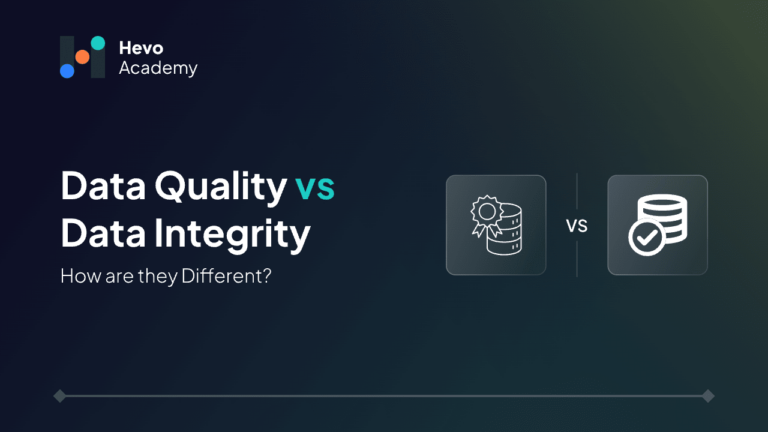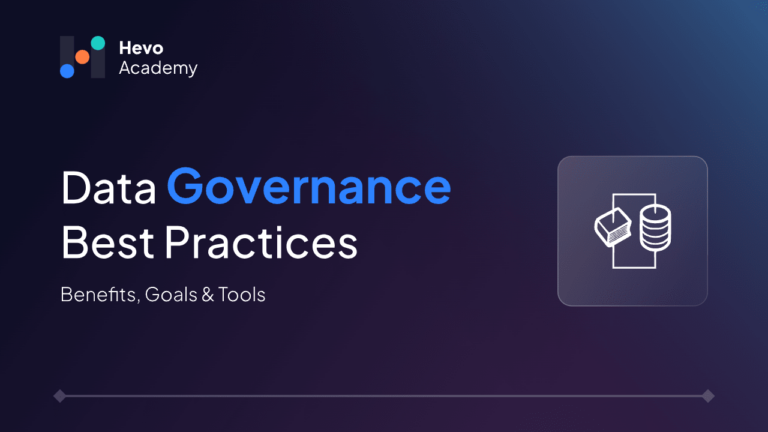“You can have all of the fancy tools, but if [your] data quality is not good, you’re nowhere.” – Veda Bawo, director of data governance, Raymond James
Table of Contents
No matter how advanced your tech stack is or how sophisticated your analytics tools are, without a solid data quality strategy in place, your insights and decisions are at risk. Poor data quality can lead to inaccurate reporting, flawed analytics, and misguided business strategies.
In this blog, we’ll explore how building a winning data quality strategy ensures your data is reliable, consistent, and ready to fuel impactful decisions. Let’s dive into the essential steps and best practices to achieve this.
Hevo, a no-code data integration platform, simplifies the process of ensuring data accuracy across your pipeline. It automates data integration, transformation, and validation processes, allowing you to implement a robust data quality strategy effortlessly.
Key Benefits of Using Hevo:
- Automated Data Validation: Hevo ensures that your data is accurate and reliable throughout your pipeline.
- Anomaly Detection: Spot inconsistencies and potential issues before they impact your analysis.
- Real-Time Integration: Maintain up-to-date, high-quality data with Hevo’s real-time data syncing.
- No-Code Platform: Save time and resources by setting up a data quality strategy without coding.
Focus on scaling your operations—let Hevo take care of your data quality needs.
Get Started with Hevo for FreeWhat is Data Quality?
Data quality can be defined as the state of data in respect to various parameters like accuracy, completeness, reliability, and relevance. In other words, high-quality data is accurate, reliable, and (fit for the intended) purpose. Relying on your data is very encouraging, especially when it is of great value to your business.
Why is Data Quality Important in Business?
This means that in today’s business world, data is one of the most valuable resources organizations have to use when it comes to decision-making. Inaccurate data can result in incorrect decisions, utilization of incorrect resources, and lost opportunities. Businesses must obtain essential and accurate data, which can help them identify customer needs and satisfaction, internal processes to enhance, and additional ways to increase income. It creates the basis for utilizing data to transform threats into opportunities for growth to support evidence-based decision-making processes.
Well-structured data assists organizations to capture more information about their customers, enhance their goods and services, and enhance business operations. While quality data creates strong values and high returns, its opposite, poor-quality data, result in inefficient and ineffective market strategies, adverse operations, and loss of competitive advantage.
Take a look at a few tips and strategies how you can improve data quality of your organization.
What is a Data Quality Strategy?
A data quality strategy is defined as a roadmap that enables an organization to ensure data is accurate, comprehensive, and relevant. It involves processes and procedures, as well as equipment and guidelines, that are required to maintain data accuracy and relevance to the company’s objectives. The main objective is to avoid or detect and correct any issues with data to maintain its integrity and accuracy for decision-making and general use.
Components of a Data Quality Strategy
- Assessment: Measure the current state of data quality and assess the missing points.
- Data Governance: It is important to quantify data management policies, roles and responsibilities.
- Monitoring and Reporting: Monitor data usage and quality with reference to the quality metrics and problems.
- Improvement Plan: Create a plan for regular practical improvements.
Data Quality Strategy Flowchart

This diagram presents a conceptual roadmap for a data quality management initiative; the steps for sourcing, assessing, enhancing, and maintaining good data in an organization. For maintaining high data quality, it’s crucial to differentiate between metadata and master data, as each impacts data integrity and usability in unique ways.
What does a Successful Data Quality Strategy Look Like?
1. Define Clear & Measurable Data Quality Goals
Always set specific and measurable goals that can be used to attain high-quality data. For example, the target of achieving 95 percent data accuracy in the first six months is clear and highly achievable.
Key Takeaway: Establish key performance indicators based on which plans can be made to ensure that the quality of data is not negated but enhanced.
2. Leverage Data Profiling for Deep Insights
Data profiling plays into the evaluation of the current collected data to determine structure, relationships, and more significantly, patterns. It allows one to spot trends that are out of the norm and points that require an organization’s attention when it comes to data management.
Key Takeaway: Regularly profile your data to identify anomalies, inconsistencies, and trends that could impact business operations.
3. Promote Data Ownership and Accountability
The definition of ownership ensures that there is a proper check and balance of data, thus ensuring that all the people handling data are held accountable at different levels of the organization.
Key Takeaway: Establish clear data ownership and accountability at all levels so that data quality becomes a shared responsibility.
4. Measure Success with Data Quality Metrics
This way, it is easy to monitor primarily-set data quality on a regular basis because of the established metrics. Such insights help to understand if the business data is of high quality and whether it is possible to achieve better results.
Key Takeaway: What can be quantified should include accuracy, completeness, and timeliness.
Criteria for Measuring Data Quality
- Accuracy: Data accuracy enables information to be correct and to contain no error or misinformation. It is useful for accurate decision making and eradicating misinterpretation scenarios that may lead to wrong decisions or actions.
- Completeness: Completeness refers to the condition in which all the relevant data elements are available in the data set. Behind every missing data there lies a great possibility of missing critical aspects of the analyses together with weighing down the overall business efficiency.
- Consistency: This is important for standardization in a way that the data are similar across the various databases and systems. Lack of clear correlations and variability of data can lead to confusion and mistakes in analysis and the company receives unreliable information.
- Uniqueness: In the context of data quality, uniqueness is said when there are little or no records that are duplicates. Duplicate data may therefore lead to higher counts and unnecessary expenses in data management, hence complicating matters.
- Validity: Validity helps in ascertaining that all the data collected complies with some prescribed format and standard. Data that do not meet these requirements are likely to lead to a variety of problems in processing and analysis and thus affecting the data value.
- Timeliness: A timeliness of data means that data is qualitative and available at the rightful time. Imprecise data result in decisions made on the wrong information and thus the business response and accuracy of its actions may be off-baseline.
- Relevance: Relevance helps to make data meaningful and applicable to the existing environment of a business. In excess, such data could complicate the existing systems and even affect decision making through concealment of important information.
- Integrity: Data integrity ensures that a link between a set of data is preserved in a correct state. It checks that relatedness and coupling within the data is correct, eliminating mistakes and incompatibilities with other data sets.
Steps to Ensure Data Quality
The following steps may assist in creating a solid data quality strategy:
- Identify Data Requirements: Identify what data your organization requires by communicating with other people and syncing with organizational objectives. Determine which data has to be collected internally and which externally to make sure you obtain correct data.
- Define Data Quality Metrics: Establish clear specification of accuracy, completeness and consistency and require data timeliness. Such metrics enable an assessment of the quality standards of data and come in handy in making improvements.
- Data Profiling and Assessment: All data is unique, so at this step, it is helpful to look at the table of data to better understand its shape and quality. Through the examination of the data distribution, the type of data, the data completeness and the patterns it exhibits, it is possible to identify problems that may exist as well as areas that require improvement.
- Data Cleansing and Enrichment: Improve the quality of data by normalizing, cleaning, deduplicating, and augmenting it with other data obtained from more accurate sources.
- Implement Data Validation: Set up and apply rules and regulations on data entry to enhance the quality of data recorded. To correct the mistakes done by the users when using the app, then offer validation in real-time to enable the users to correct their mistakes.
- Establish Data Governance: Establish a strong governance structure that includes ownership responsibility, data stewards, and relevant policies to support the quality maintaining of data organization wide. In line with Gartner’s data governance framework, organizations benefit from assigning clear ownership and stewardship roles to promote consistent data quality.
- Keeping track and quantifying the quality of data: Particularly, ensure that data quality is checked and monitored through reviews and quality dashboards in a continuous manner. Use tracking methodologies that can flag any problems at the initial stage and ensure superior quality of data.
- Continuous Improvement: It is suggested to perform frequent cause-and-effect diagnostic outcomes’ review, consider user input, and optimize data-related activities. Maintain a culture of continuous improvement to guarantee that data remains relevant and accurate.
Tips and Best Practices
The data quality is critical to any company in order to make the right decisions and have a running business. Here are some actionable tips to help you get started:
1. Carry out a Data Audit as First Step
Start addressing the strategic planning it is important to find out where exactly a company is. Identify if there are some data quality challenges in the enterprise such as missing data, data duplication or even outdated data. It provides you with a snapshot of where you are now, and can help target the areas of most improvement. Incorporating regular data quality testing into your quality strategy can ensure that data remains reliable, accurate, and fit for analysis or decision-making purposes.
Tip: Utilize the data profiling tools to enhance the audit process by making them more efficient and effective.
2. Design Data with the End-User in Mind
Consider your data as a service as a product, like any other services you provided. Ensure it is accurate, user-friendly, and functional for the various departments and roles in your company. Whether it is the marketing team studying how customers behave or operations researching supply chain, your data should be able to inform decision making.
Tip: Engage stakeholders in the data design process so that the collected data will address their needs.
3. Key Metrics as Definition of Success
It can be stated that you can’t improve what you don’t measure. Create objectives that are specific, measurable for optimal execution of data quality. For example, one can set goals like reducing duplication of records by 90% or achieving a data accuracy standard of 95% within six months. These are the signposts that can help you to measure the progress and facilitate the necessary adjustments to the strategy when necessary.
Tip: Use a data quality dashboard to monitor your progress regarding the identified key metrics.
4. Employ the R-E-A-L Principle
When crafting your data quality strategy, make sure your data aligns with these four critical principles:
- Reliable: Your data should be reliable to help you make critical business decisions.
- Easy to Access: Access to information should be allowed to the appropriate individuals at the necessary time.
- Accurate: Always keep your data accurate and always updated.
- Legally Compliant: You must ensure that all your data practices are in full compliance with the law and regulation.
Conclusion
Data quality plays a key role in providing accurate information to inform the business decisions that lead to increased customer satisfaction. Through data audit, linking the data with business goals, and embracing standards such as data governance and data validation, an organization lays a strong structure necessary for success in the long run. Data quality must be continuously monitored to guarantee that it is timely, correct, complete, and non-redundant, and the findings must be shared with all users. Unfortunately, organizations have realized that focusing on the quality of the data is not only advantageous but necessary to retain competitiveness and have lasting strategic goals.
When organizations gather more sophisticated data, it becomes especially important to have a solid data quality approach. Data can only be leveraged if properly integrated into the companies’ strategies, which would take time and effort, thus giving companies that direction long-term competitiveness.
Schedule a personalized demo with Hevo for seamless data integration.
FAQs
1. What is a data quality strategy?
A data quality strategy is a plan that organizations use to make sure their data is accurate, complete, and trustworthy. This helps them make better decisions.
2. What is the first step in improving data quality?
The first and most important step is to determine the type of data your business requires. This helps you to make sure that you are gathering appropriate data that will enable you to run your operations.
3. What are data quality 5 Cs?
The 5 Cs are considered as consent, clarity, consistency, control, and consequences. It defines how data should be handled so that the privacy of the data is retained and it remains useful.
4. What are the 4 principles of data quality?
It consists of four fundamental pillars, which are accuracy, completeness, consistency and timeliness. These are used to assess and enhance the quality of data for superior business outcomes.





